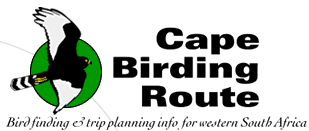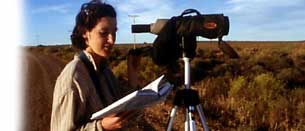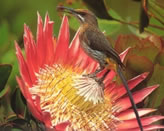Entering
the Strandveld: Silwerstroomstrand
Uniform
thickets of tall vegetation line the road as you head north
along the R27, beyond the ever-expanding borders of Cape Town.
These alien trees, introduced from Australia in the 19th century
to stabilize the dunes, continue to spread and smother the
indigenous plants. Resisting most attempts to root them from
the landscape, they currently pose one of the greatest threats
to the natural vegetation. As you proceed further north, the
low, scrubby plant cover native to the area becomes more evident.
Here referred to broadly as ‘strandveld’ (although
it contains elements of lowland fynbos, see p.7), it occurs
on very sandy soils and is characterized by low, dense, thicket
vegetation (with many fruit-bearing shrubs) interspersed with
stands of restios (brown, reed-like plants), and supports
a rich bird community.
Interestingly,
the prominent hill on the right, close to the R27, is the
site of a battle that had a decisive influence on the course
of history in South Africa. It was after this confrontation,
nearly two centuries ago, that an invasion force of 63 British
warships captured the Cape and brought 150 years of Dutch
rule at the southern tip of Africa to an abrupt end. On the
left, only 30 km from the centre of Cape Town, loom the controversial
reactor domes of South Africa’s only nuclear power station,
Koeberg. Black-shouldered Kite, Pied Crow and
Fiscal Shrike are common roadside birds along the R27,
and they are joined in summer by Steppe Buzzard and
Yellow-billed Kite. From Koeberg northwards, strandveld
vegetation is largely dominant and there are a number of places
where one can gain access to its birds.
In
early 2000, seve-ral massive fires swept over much of the
West Coast south of Lange-baan and devastated huge tracts
of its vegetation, which can now be seen in various stages
of recovery.
Silwerstroomstrand
is the closest prime strandveld site to Cape Town, and supports
a rich diversity of birds. Take the ‘Silwerstroomstrand’
turn-off to the left 32.7 km, north of the ‘Dolphin Beach’
pans, and park on the edge of the road after 0.8 km.
The
thicker vegetation harbours species such as the White-backed
Mousebird, Karoo Lark (common, but inconspicuous),
Cape Penduline
Tit (p.81), Cape Bulbul, Cape Robin,
Karoo Robin, Titbabbler, Layard’s Titbabbler,
Grey-backed Cisticola, Long-billed Crombec,
Bar-throated Apalis, Grassbird, Bokmakierie,
Lesser Double-collared Sunbird, Malachite Sunbird,
Cape Weaver, and Yellow and White-throated
Canaries, while the more open patches should be searched
for Grey-wing Francolin (their calls can be heard early
in the morning), Southern
Black Korhaan (p.57*), Clapper
Lark (see p.116*; uncommon) and Cape Bunting.
Even the rare Hottentot
Buttonquail (see p.23) has been flushed here.
|


